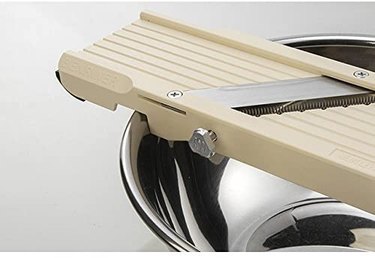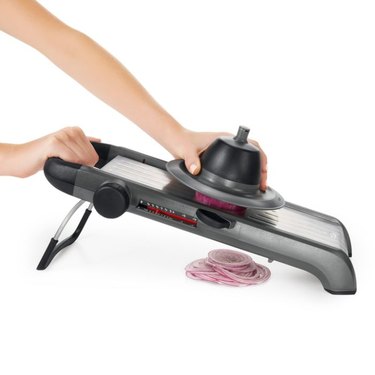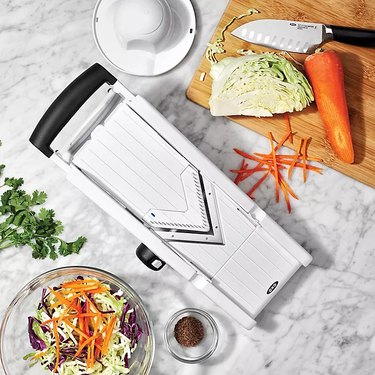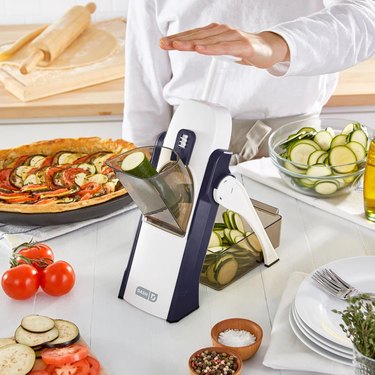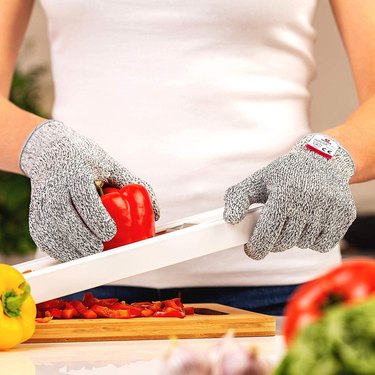
Cutting a vegetable with a knife is pretty easy. Making perfectly even slices is a lot harder, and cutting perfect julienne requires professional-level skills. That's why we have mandoline slicers: It's much easier to just move the food, and let a fixed blade do the actual cutting. It's not just an aesthetic issue. Aside from looking nicer, perfect slices or sticks cook (and chew) more evenly as well.
Mandolines aren't a fundamental part of the kitchen in the same way that knives are, and if you're unfamiliar with them you may not know how to choose between all of the different models you'll see online and in stores. Don't worry, we've got you covered. Here are a handful of your best choices, and our reasons for considering them the standouts.
Video of the Day
Video of the Day
What to Consider When Purchasing a Mandoline Slicer
To begin with, there are two basic styles of mandoline. One type is freestanding, with feet or a folding stand to hold it upright on the counter. The other type is handheld; you simply hold it over your work area (or lean it on a cutting board or counter) when you need to slice things. As a broad rule, freestanding mandolines are typically more versatile but bulkier and more complicated, while handheld mandolines are usually simple slicers with fewer features. That being said, there are exceptions to both rules.
Before you plunk down your credit card, take time to consider your likely usage. Few of us actually need the kind of classic, heavy-steel European mandoline you'll see in movies (though if pro-grade gear is your thing, you can certainly buy one). If you just want to make quick salads, a simple slicer might be all you need. If you're an adventurous cook, or if physical challenges are taking away your knife skills, you might need something more robust. Here are a few points to consider as you evaluate mandolines:
Physical Size: A mandoline is probably not something you'll use every day, so getting something that's compact and easy to store is a definite bonus. On the other hand, a wide deck (the flat part of the mandoline) and blade means you'll be able to work with larger items, like globe eggplants or oversized russet potatoes. If the mandoline is intended to help you overcome physical challenges in the kitchen, having one you can easily lift and move is also important.
Hand Guard: A mandoline is theoretically safer to use than a knife, because the blade is fixed and can't move toward your hand. Your hand does move toward the blade, though, and that's why the hand guard—the piece you use to hold the item you're slicing—holds such outsized importance. A good one grips the food securely, slides freely along the deck (sticking is bad), and of course, is comfortable to hold and use.
Cutting Options: There are two main ways you can adjust a mandoline for different slicing options. One is by adjusting the gap between the deck and the blade; and the other is by switching out the blade for one that makes a different-sized cut. Blade-switching is innately limited: If your mandoline has three blades, then you can make just three different cuts. Models that adjust the blade do that either by clicking between multiple settings, or continuous adjustment with a dial. Continuous adjustment offers fine control over thickness, but click-setting gives consistency from one use to the next. Both have their advantages.
Staying Sharp: A mandoline is only useful when its blades are razor-sharp. With time and use they'll lose their edge, just as knives do, and need to be sharpened or replaced. Top models typically offer the option of either sharpening or replacing your blades, but budget mandolines are often intended to be disposable. That's okay too, as long as it's a choice you knowingly make (and as long as the price point makes "disposable" an acceptable option).
Note that this roundup omits a variety of special-purpose mandolines, from spiralizers and sheet-slicers to combo units including chopping, grating and other functions. Look for those to be reviewed separately.
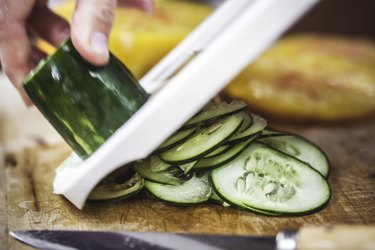
The Best Overall Handheld Mandoline Slicer
Benriner Classic Slicer
The big, heavy traditional steel mandoline was designed for restaurant use, but unless you'll be using it all day, it may not be worth the time and trouble involved in setting it up. Working chefs are more likely to reach for a Benriner instead because it's faster and simpler. This is the classic handheld mandoline, complete with four blades for making straight cuts and various sizes of "sticks." Thickness is continuously adjustable for fine control over your slicing, and the whole unit is top-rack dishwasher safe. The blades are replaceable, and the flat blade can be sharpened, so you can use your Benriner for years. Its only drawbacks are that the hand guard is notoriously not its strongest feature, and the standard slicer's deck is relatively narrow. If you want the flexibility to cut larger items, you'll need to upgrade to the wider Super Slicer model.
Tip
There's a straightforward "cheat" you can use to get consistent slices every time from a mandoline (like the Benriner) with a continuously-adjustable blade. Find something in approximately the correct thickness, in a material that won't damage the blade—a plastic ruler, the edge of a nylon spatula, a wooden stir-stick—and use that as your gauge. Open the blade, insert your chosen item, and then close the blade until it makes contact. Remove your gauge, and begin slicing.
The Best Value Handheld Mandoline Slicer
Kyocera Advanced Ceramic Adjustable Mandoline Slicer
At such a modest price, there's a lot to like about this slicer. First, the ceramic blade (Kyocera began life as the Kyoto Ceramics Company) is ridiculously sharp, and the company claims it'll hold its edge up to 10 times longer than stainless steel, and won't rust in the dishwasher. It has some thoughtful touches, too, like notches on the underside of the deck so the slicer will sit securely on top of your bowl or pot as you work. The blade has four thickness settings, and the hand guard is usable and effective. The slicer is even available in four bold colors to complement your kitchen design. One potential downside is that this is a pure unitasker and only makes straight slices. If you want to julienne vegetables, for example, you'll need to buy a separate slicer.
The Best Consumer-Grade Freestanding Mandoline Slicer
OXO Good Grips Chef's Mandoline 2.0
There's really a lot to like about this update on OXO's original mandoline, and for anyone who's not a culinary professional, it will almost certainly do everything you need. Like its smaller V-blade sibling, this one includes four blades, but it has additional thickness settings for a total of 21 possible cuts. Better yet, the thickness setting is plainly visible from above, and marked in both inches and millimeters, so you'll know at a glance that you're using the correct setting. The handle and hand guard are as well-designed as you'd expect from a collection called Good Grips, and are comfortable to use. There's even an all-steel version available at a slightly higher price, if that's your thing. As with the smaller OXO model, the only real downside here is that you could conceivably cut yourself while changing a blade.
The Best Value Freestanding Mandoline Slicer
OXO Good Grips V-Blade Mandoline Slicer
This model is surprisingly capable for a value-priced mandoline. It's compact and lightweight, easy to use, and the hand guard is as good as any you'll find. The deck is adjustable to four thicknesses of cut, and the unit comes with four interchangeable blades (straight, wavy, julienne and french fry), so it provides a total of 16 possible variations in your cut. The V-shaped blade is very sharp—especially when new—and even does a pretty good job on things like tomatoes, which are usually problematic on a lower-priced slicer. You can also order replacement blades inexpensively from OXO. The unit's only real fault is that, like any other model with interchangeable blades, there's always a risk of cutting yourself on the blade while you're handling it.
The Safest Mandoline Slicer
Dash Safe Slice Mandoline Slicer
Despite the disclaimer above, about not considering special-purpose mandolines, the Dash is a unique case. It's marketed as the safest mandoline you can buy, and that's probably accurate. Your hands never come near the blade—instead, you place the foods into a feed tube (rather like the one on your food processor) and then press a plunger at the top of the unit to slide the actual blade down the deck and make slices. It accomplishes its safety goal pretty handily; if you wanted to cut yourself on this slicer, you'd almost have to do it deliberately. There are multiple blades and thicknesses to choose from, so it's also a reasonably versatile slicer for the price point.
It's decidedly not perfect. There are a lot of parts here to manage, and you'll have to pre-cut many foods so they can fit into the feed tube. It can also be time-consuming to clean once you're done. On the positive side, if you struggle to prepare foods because of physical challenges, the Dash's unique design may make it your best option.
Bonus: The Most Indispensable Mandoline Accessory
NoCry Cut-Resistant Gloves
At the end of the day, any food-slicing tool with a blade can also potentially slice your hand. That's especially true if the mandoline's hand guard is inconvenient or difficult to use. Prep cooks in restaurants often leave off the hand guard entirely, which—as you'd expect—often results in injury. One of the most useful accessories you can buy for your mandoline is a pair of cut-resistant gloves, which provide commercial-grade protection against cutting yourself. With a glove on your hand, a clumsy swipe that might otherwise take away your fingertip will usually result in nothing more than a scare.
Look for gloves that are rated for food-prep or meat cutting use, like these ones from NoCry. They'll be described as either Level 5 (the old-style rating) or Level A7 to A9 (the new-style rating). The NoCry gloves are machine washable, have a limited lifetime warranty, and their textured finish actually makes it easier to hold slippery foods. That's a solid win (and they'll protect you from knives, as well).
